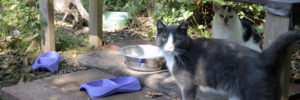Feeding Tips
Community Cat Feeding Tips
Providing adequate food (and water) for the cats on a regular basis, year-round, is a cornerstone of good colony care. Feed during daylight hours for your safety and so that you can easily assess the members of the colony.
How Much Is Enough?
The amount of food a cat needs depends on their size, their level of activity, the weather, the brand of food, and what other food sources are available. Expect an adult feral cat to eat roughly 200 calories per day, plus or minus 20–30 calories. This works out to about 5.5 ounces of wet (canned) food plus 1/8-cup of dry food per day (increase to a half-cup if only feeding dry). Some cats will eat considerably more food, others less, so you may need to experiment in order to find the ideal amount.
While gauging how much to leave, observe the cats and use your discretion based on the time it takes for the food to be eaten. If the cats eat all of the food in 15 minutes or less, consider putting out a bit more. If there is consistently food remaining after a half hour, put out a bit less. Be aware, though, that some of the cats you are feeding may not approach the feeding station when a human is present.
Seasonal Considerations
Although wet food has distinct health benefits compared to dry food, feeding a colony dry food alone may be necessary in extreme heat and cold. If you know the colony will eat right away, and you plan to feed canned food in cold weather, consider warming the food prior to arriving at the site and using insulated bags to keep the food warm during travel. Hand warmers placed under the wet food bowls will also help to keep the food from freezing.
In the winter, especially in colder locations, expect the colony to consume more food because they will need extra calories to maintain their body heat. Also, by fueling a cat’s immune system with the best nutrition you can afford, you will provide him or her with the best defense against illness.
Pest Control
To discourage other animals, insects, and wildlife, the goal is to put out only as much food as the cats can finish in a relatively short period of time. Excessive amounts of food can attract rodents, slugs, and flies, which may lead to complaints from neighbors. Determining the right amount of food may take some trial and error, but is worth it.
Pecking Order
Within a colony, cats with seniority or stronger personalities may eat before those who are lower on the social scale. Do not be concerned about or try to manage this social interaction. It is perfectly normal, and as long as you leave enough food for everyone, the shy ones will get their share. By keeping a consistent feeding time, the cats will learn when to expect food and they will be waiting for you to arrive.
Winter Shelters
Shelters are crucial to keeping your community cats healthy and protected during winter months.

